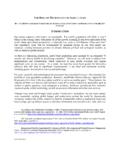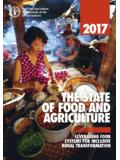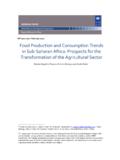Transcription of THE STATE OF FOOD AND AGRICULTURE
1 THE STATE OF food AND AGRICULTUREWOMEN IN AGRICULTUREC losing the gender gap for development How much do women contribute to AGRICULTURE and rural economies? Why do female farming households produce less than men? What is the gender gap in AGRICULTURE including land, livestock, education, financial services, extension, technology and rural employment? How much does it cost society in lost agricultural output and food security? Do agro-processing and contract farming offer opportunities for women?
2 Can agricultural policies and programmes close the gender gap?World food and AGRICULTURE in reviewStatistical annex of sex-disaggregated data2010 11 WOMEN IN AGRICULTURE : Closing the gender gap for developmentThe STATE of food and AGRICULTURE 2010 11 makes the business case for addressing gender issues in AGRICULTURE and rural employment. The AGRICULTURE sector is underperforming in many developing countries, in part because women do not have equal access to the resources and opportunities they need to be more productive.
3 The gender gap imposes real costs on society in terms of lost agricultural output, food security and economic growth. Promoting gender equality is not only good for women; it is also good for agricultural make essential contributions to the rural economy of all developing country regions as farmers, labourers and entrepreneurs. Their roles are diverse and changing rapidly, so generalizations should be made carefully. Yet one fact is strikingly consistent across countries and contexts: women have less access than men to agricultural assets, inputs and services and to rural employment opportunities.
4 This report documents the different roles played by women in rural areas of developing countries and provides solid empirical evidence on the gender gaps they face in AGRICULTURE and rural employment. Compared with their male counterparts, women: operate smaller farms, on average only half to two-thirds as large; keep fewer livestock, typically of smaller breeds, and earn less from the livestock they do own; have a greater overall workload that includes a heavy burden of low-productivity activities like fetching water and firewood; have less education and less access to agricultural information and extension services; use less credit and other financial services.
5 Are much less likely to purchase inputs such as fertilizers, improved seeds and mechanical equipment; if employed, are more likely to be in part-time, seasonal and low-paying jobs; and receive lower wages for the same work, even when they have the same experience and qualifications. THE STATE OF food AND AGRICULTURE2010 11 Percentage of households using mechanizationMechanical equipment use by female- and male-headed householdsFemale-headed householdsMale-headed households05101520253035404550 NigeriaMalawiMadagascarGhanaViet NamTajikistanNepalIndonesiaBangladeshPan amaNicaraguaGuatemalaEcuadorWOMEN IN AGRICULTURE .
6 Closing the gender gap for developmentThe STATE of food and AGRICULTURE 2010 11 makes the business case for addressing gender issues in AGRICULTURE and rural employment. The AGRICULTURE sector is underperforming in many developing countries, in part because women do not have equal access to the resources and opportunities they need to be more productive. The gender gap imposes real costs on society in terms of lost agricultural output, food security and economic growth. Promoting gender equality is not only good for women; it is also good for agricultural make essential contributions to the rural economy of all developing country regions as farmers, labourers and entrepreneurs.
7 Their roles are diverse and changing rapidly, so generalizations should be made carefully. Yet one fact is strikingly consistent across countries and contexts: women have less access than men to agricultural assets, inputs and services and to rural employment opportunities. This report documents the different roles played by women in rural areas of developing countries and provides solid empirical evidence on the gender gaps they face in AGRICULTURE and rural employment. Compared with their male counterparts, women: operate smaller farms, on average only half to two-thirds as large; keep fewer livestock, typically of smaller breeds, and earn less from the livestock they do own; have a greater overall workload that includes a heavy burden of low-productivity activities like fetching water and firewood; have less education and less access to agricultural information and extension services; use less credit and other financial services.
8 Are much less likely to purchase inputs such as fertilizers, improved seeds and mechanical equipment; if employed, are more likely to be in part-time, seasonal and low-paying jobs; and receive lower wages for the same work, even when they have the same experience and qualifications. The STATE of food and AGRICULTURE 2010 11 presents empirical estimates of the potential gains that could be achieved by closing the gender gap in AGRICULTURE and rural employment. The report critically evaluates experiences from many countries with gender and development policies.
9 It offers proven measures to promote gender equality and empower women. It shows how agricultural policies and programmes aimed at closing the gender gap can also generate significant gains for the AGRICULTURE sector, food security and society as a messages of the report Women comprise, on average, 43 percent of the agricultural labour force in developing countries. This average share ranges from 20 percent in Latin America to 50 percent in Eastern Asia and sub-Saharan Africa. Their contribution to agricultural work varies even more widely depending on the specific crop and activity.
10 Women in AGRICULTURE and rural areas have less access than men to productive resources and opportunities. The gender gap is found for many assets, inputs and services and it imposes costs on the AGRICULTURE sector, the broader economy and society as well as on women themselves. Female farmers produce less than male farmers, but not because they are less-efficient farmers extensive empirical evidence shows that the productivity gap between male and female farmers is caused by differences in input use.












